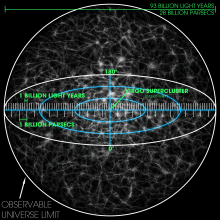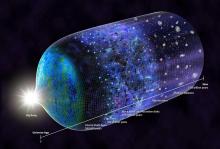Listen to today's episode of StarDate on the web the same day it airs in high-quality streaming audio without any extra ads or announcements. Choose a $8 one-month pass, or listen every day for a year for just $30.
You are here
Young Giants
A galaxy from the early universe appears to be churning out massive stars the way GM churns out cars — by the bunch.
The galaxy is more than 13 billion light-years away. That means we see it as it looked when the universe was just a few hundred million years old.
Astronomers from Texas A&M, the University of Texas, and other institutions studied the galaxy with one of the giant Keck telescopes in Hawaii.
The scientists are looking at an era when the universe went from transparent to opaque then back again. It became opaque when conditions after the Big Bang cooled enough for protons and electrons to join to make atoms of hydrogen. That was like water molecules binding together to make droplets — it created a sort of cosmic fog. But energy from early stars and galaxies split the atoms apart again, banishing the fog.
Studying this era shows when the fog dissipated. It also reveals details about the birth of those early stars and galaxies.
The galaxy studied with the Keck telescope, for example, could be giving birth to stars up to 300 times the mass of the Sun. Almost no stars are born that heavy in the modern universe. But the mixture of elements in the early universe produced stars that were massive, hot, and brilliant.
A possible supermassive black hole in the center of the galaxy could be responsible for some of its energy. But much of it could be coming from massive stars — brilliant beacons from the early universe.
Script by Damond Benningfield





